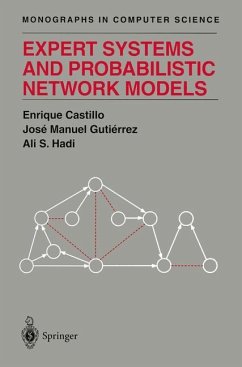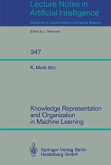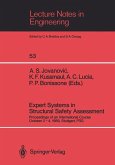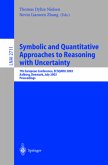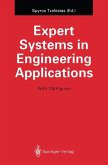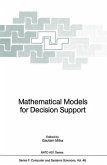- Broschiertes Buch
- Merkliste
- Auf die Merkliste
- Bewerten Bewerten
- Teilen
- Produkt teilen
- Produkterinnerung
- Produkterinnerung
Artificial intelligence and expert systems have seen a great deal of research in recent years, much of which has been devoted to methods for incorporating uncertainty into models. This book is devoted to providing a thorough and up-to-date survey of this field for researchers and students.
Andere Kunden interessierten sich auch für
![Building Expert Systems in Prolog Building Expert Systems in Prolog]() Dennis MerrittBuilding Expert Systems in Prolog75,99 €
Dennis MerrittBuilding Expert Systems in Prolog75,99 €![Knowledge Representation and Organization in Machine Learning Knowledge Representation and Organization in Machine Learning]() Knowledge Representation and Organization in Machine Learning39,99 €
Knowledge Representation and Organization in Machine Learning39,99 €![Expert Systems in Structural Safety Assessment Expert Systems in Structural Safety Assessment]() Expert Systems in Structural Safety Assessment77,99 €
Expert Systems in Structural Safety Assessment77,99 €![Frontiers of Expert Systems Frontiers of Expert Systems]() Chilukuri Krishna MohanFrontiers of Expert Systems115,99 €
Chilukuri Krishna MohanFrontiers of Expert Systems115,99 €![Symbolic and Quantitative Approaches to Reasoning with Uncertainty Symbolic and Quantitative Approaches to Reasoning with Uncertainty]() Thomas D. Nielsen / Nevin L. Zhang (eds.)Symbolic and Quantitative Approaches to Reasoning with Uncertainty77,99 €
Thomas D. Nielsen / Nevin L. Zhang (eds.)Symbolic and Quantitative Approaches to Reasoning with Uncertainty77,99 €![Expert Systems in Engineering Applications Expert Systems in Engineering Applications]() Expert Systems in Engineering Applications75,99 €
Expert Systems in Engineering Applications75,99 €![Mathematical Models for Decision Support Mathematical Models for Decision Support]() Mathematical Models for Decision Support77,99 €
Mathematical Models for Decision Support77,99 €-
-
-
Artificial intelligence and expert systems have seen a great deal of research in recent years, much of which has been devoted to methods for incorporating uncertainty into models. This book is devoted to providing a thorough and up-to-date survey of this field for researchers and students.
Produktdetails
- Produktdetails
- Monographs in Computer Science
- Verlag: Springer / Springer New York / Springer, Berlin
- Artikelnr. des Verlages: 978-1-4612-7481-0
- Softcover reprint of the original 1st ed. 1997
- Seitenzahl: 624
- Erscheinungstermin: 15. September 2011
- Englisch
- Abmessung: 235mm x 155mm x 34mm
- Gewicht: 932g
- ISBN-13: 9781461274810
- ISBN-10: 1461274818
- Artikelnr.: 36119720
- Herstellerkennzeichnung
- Springer-Verlag GmbH
- Tiergartenstr. 17
- 69121 Heidelberg
- ProductSafety@springernature.com
- Monographs in Computer Science
- Verlag: Springer / Springer New York / Springer, Berlin
- Artikelnr. des Verlages: 978-1-4612-7481-0
- Softcover reprint of the original 1st ed. 1997
- Seitenzahl: 624
- Erscheinungstermin: 15. September 2011
- Englisch
- Abmessung: 235mm x 155mm x 34mm
- Gewicht: 932g
- ISBN-13: 9781461274810
- ISBN-10: 1461274818
- Artikelnr.: 36119720
- Herstellerkennzeichnung
- Springer-Verlag GmbH
- Tiergartenstr. 17
- 69121 Heidelberg
- ProductSafety@springernature.com
Preface.- 1 Introduction.- 1.1 Introduction.- 1.2 What Is an Expert System?.- 1.3 Motivating Examples.- 1.4 Why Expert Systems?.- 1.5 Types of Expert System.- 1.6 Components of an Expert System.- 1.7 Developing an Expert System.- 1.8 Other Areas of AI.- 1.9 Concluding Remarks.- 2 Rule-Based Expert Systems.- 2.1 Introduction.- 2.2 The Knowledge Base.- 2.3 The Inference Engine.- 2.4 Coherence Control.- 2.5 Explaining Conclusions.- 2.6 Some Applications.- 2.7 Introducing Uncertainty.- Exercises.- 3 Probabilistic Expert Systems.- 3.1 Introduction.- 3.2 Some Concepts in Probability Theory.- 3.3 Generalized Rules.- 3.4 Introducing Probabilistic Expert Systems.- 3.5 The Knowledge Base.- 3.6 The Inference Engine.- 3.7 Coherence Control.- 3.8 Comparing Rule-Based and Probabilistic Expert Systems.- Exercises.- 4 Some Concepts of Graphs.- 4.1 Introduction.- 4.2 Basic Concepts and Definitions.- 4.3 Characteristics of Undirected Graphs.- 4.4 Characteristics of Directed Graphs.- 4.5 Triangulated Graphs.- 4.6 Cluster Graphs.- 4.7 Representation of Graphs.- 4.8 Some Useful Graph Algorithms.- Exercises.- 5 Building Probabilistic Models.- 5.1 Introduction.- 5.2 Graph Separation.- 5.3 Some Properties of Conditional Independence.- 5.4Special Types of Input Lists.- 5.5 Factorizations of the JPD.- 5.6 Constructing the JPD.- Appendix to Chapter 5.- Exercises.- 6 Graphically Specified Models.- 6.1 Introduction.- 6.2 Some Definitions and Questions.- 6.3 Undirected Graph Dependency Models.- 6.4 Directed Graph Dependency Models.- 6.5 Independence Equivalent Graphical Models.- 6.6 Expressiveness of Graphical Models.- Exercises.- 7 Extending Graphically Specified Models.- 7.1 Introduction.- 7.2 Models Specified by Multiple Graphs.- 7.3 Models Specified by Input Lists.- 7.4 Multifactorized Probabilistic Models.- 7.5 Multifactorized Multinomial Models.- 7.6 Multifactorized Normal Models.- 7.7 Conditionally Specified Probabilistic Models.- Exercises.- 8 Exact Propagation in Probabilistic Network Models.- 8.1 Introduction.- 8.2 Propagation of Evidence.- 8.3 Propagation in Polytrees.- 8.4 Propagation in Multiply-Connected Networks.- 8.5 Conditioning Method.- 8.6 Clustering Methods.- 8.7 Propagation Using Join Trees.- 8.8 Goal-Oriented Propagation.- 8.9 Exact Propagation in Gaussian Networks.- Exercises.- 9 Approximate Propagation Methods.- 9.1 Introduction.- 9.2 Intuitive Basis of Simulation Methods.- 9.3 General Frame for Simulation Methods.- 9.4 Acceptance-Reject ion Sampling Method.- 9.5 Uniform Sampling Method.- 9.6 The Likelihood Weighing Sampling Method.- 9.7 Backward-Forward Sampling Method.- 9.8 Markov Sampling Method.- 9.9 Systematic Sampling Method.- 9.10 Maximum Probability Search Method.- 9.11 Complexity Analysis.- Exercises.- 10 Symbolic Propagation of Evidence.- 10.1 Introduction.- 10.2 Notation and Basic Framework.- 10.3 Automatic Generation of Symbolic Code.- 10.4 Algebraic Structure of Probabilities.- 10.5 Symbolic Propagation Through Numeric Computations.- 10.6 Goal-Oriented Symbolic Propagation.- 10.7 Symbolic Treatment of Random Evidence.- 10.8 Sensitivity Analysis.- 10.9 Symbolic Propagation in Gaussian Bayesian Networks.- Exercises.- 11 Learning Bayesian Networks.- 11.1 Introduction.- 11.2 Measuring the Quality of a Bayesian Network Model.- 11.3 Bayesian Quality Measures.- 11.4 Bayesian Measures for Multinomial Networks.- 11.5 Bayesian Measures for Multinormal Networks.- 11.6 Minimum Description Length Measures.- 11.7 Information Measures.- 11.8 Further Analyses of Quality Measures.- 11.9 Bayesian Network Search Algorithms.- 11.10 The Case of Incomplete Data.- Appendix to Chapter 11: Bayesian Statistics.- Exercises.- 12 Case Studies.- 12.1 Introduction.- 12.2 Pressure Tank System.- 12.3 Power Distribution System.- 12.4 Damage of Concrete Structures.- 12.5 Damage of Concrete Structures: The Gaussian Model.- Exercises.- List of Notation.- References.
Preface.- 1 Introduction.- 1.1 Introduction.- 1.2 What Is an Expert System?.- 1.3 Motivating Examples.- 1.4 Why Expert Systems?.- 1.5 Types of Expert System.- 1.6 Components of an Expert System.- 1.7 Developing an Expert System.- 1.8 Other Areas of AI.- 1.9 Concluding Remarks.- 2 Rule-Based Expert Systems.- 2.1 Introduction.- 2.2 The Knowledge Base.- 2.3 The Inference Engine.- 2.4 Coherence Control.- 2.5 Explaining Conclusions.- 2.6 Some Applications.- 2.7 Introducing Uncertainty.- Exercises.- 3 Probabilistic Expert Systems.- 3.1 Introduction.- 3.2 Some Concepts in Probability Theory.- 3.3 Generalized Rules.- 3.4 Introducing Probabilistic Expert Systems.- 3.5 The Knowledge Base.- 3.6 The Inference Engine.- 3.7 Coherence Control.- 3.8 Comparing Rule-Based and Probabilistic Expert Systems.- Exercises.- 4 Some Concepts of Graphs.- 4.1 Introduction.- 4.2 Basic Concepts and Definitions.- 4.3 Characteristics of Undirected Graphs.- 4.4 Characteristics of Directed Graphs.- 4.5 Triangulated Graphs.- 4.6 Cluster Graphs.- 4.7 Representation of Graphs.- 4.8 Some Useful Graph Algorithms.- Exercises.- 5 Building Probabilistic Models.- 5.1 Introduction.- 5.2 Graph Separation.- 5.3 Some Properties of Conditional Independence.- 5.4Special Types of Input Lists.- 5.5 Factorizations of the JPD.- 5.6 Constructing the JPD.- Appendix to Chapter 5.- Exercises.- 6 Graphically Specified Models.- 6.1 Introduction.- 6.2 Some Definitions and Questions.- 6.3 Undirected Graph Dependency Models.- 6.4 Directed Graph Dependency Models.- 6.5 Independence Equivalent Graphical Models.- 6.6 Expressiveness of Graphical Models.- Exercises.- 7 Extending Graphically Specified Models.- 7.1 Introduction.- 7.2 Models Specified by Multiple Graphs.- 7.3 Models Specified by Input Lists.- 7.4 Multifactorized Probabilistic Models.- 7.5 Multifactorized Multinomial Models.- 7.6 Multifactorized Normal Models.- 7.7 Conditionally Specified Probabilistic Models.- Exercises.- 8 Exact Propagation in Probabilistic Network Models.- 8.1 Introduction.- 8.2 Propagation of Evidence.- 8.3 Propagation in Polytrees.- 8.4 Propagation in Multiply-Connected Networks.- 8.5 Conditioning Method.- 8.6 Clustering Methods.- 8.7 Propagation Using Join Trees.- 8.8 Goal-Oriented Propagation.- 8.9 Exact Propagation in Gaussian Networks.- Exercises.- 9 Approximate Propagation Methods.- 9.1 Introduction.- 9.2 Intuitive Basis of Simulation Methods.- 9.3 General Frame for Simulation Methods.- 9.4 Acceptance-Reject ion Sampling Method.- 9.5 Uniform Sampling Method.- 9.6 The Likelihood Weighing Sampling Method.- 9.7 Backward-Forward Sampling Method.- 9.8 Markov Sampling Method.- 9.9 Systematic Sampling Method.- 9.10 Maximum Probability Search Method.- 9.11 Complexity Analysis.- Exercises.- 10 Symbolic Propagation of Evidence.- 10.1 Introduction.- 10.2 Notation and Basic Framework.- 10.3 Automatic Generation of Symbolic Code.- 10.4 Algebraic Structure of Probabilities.- 10.5 Symbolic Propagation Through Numeric Computations.- 10.6 Goal-Oriented Symbolic Propagation.- 10.7 Symbolic Treatment of Random Evidence.- 10.8 Sensitivity Analysis.- 10.9 Symbolic Propagation in Gaussian Bayesian Networks.- Exercises.- 11 Learning Bayesian Networks.- 11.1 Introduction.- 11.2 Measuring the Quality of a Bayesian Network Model.- 11.3 Bayesian Quality Measures.- 11.4 Bayesian Measures for Multinomial Networks.- 11.5 Bayesian Measures for Multinormal Networks.- 11.6 Minimum Description Length Measures.- 11.7 Information Measures.- 11.8 Further Analyses of Quality Measures.- 11.9 Bayesian Network Search Algorithms.- 11.10 The Case of Incomplete Data.- Appendix to Chapter 11: Bayesian Statistics.- Exercises.- 12 Case Studies.- 12.1 Introduction.- 12.2 Pressure Tank System.- 12.3 Power Distribution System.- 12.4 Damage of Concrete Structures.- 12.5 Damage of Concrete Structures: The Gaussian Model.- Exercises.- List of Notation.- References.

